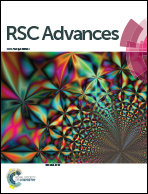Development of biocompatible nanocubes as a T1-contrast enhancer for MR imaging of primary and metastatic liver cancer†
Abstract
In this paper T1 contrast agent-enhanced magnetic resonance imaging of hepatic lesions in vivo was systematically investigated using dextran-coated KMnF3 nanocubes, a new type of contrast enhancer that we have developed recently. The water-soluble nanocubes were simply synthesized via a solution method. They showed good crystallinity and high r1 relaxivities (12 mM−1 s−1). Cellular nanotoxicity issues including cell proliferation, oxidative stress and cell membrane integrality were evaluated, and all the results confirmed the dextran-coated KMnF3 nanocubes are highly biocompatible under the test concentrations. In vivo organ distribution showed they were predominantly taken up by the liver and spleen, and excluded out of the main organs within an appropriate residual time. Histopathology of the six main organs harvested within three days of postinjection yielded no significant signs of tissue damage. Hematology and blood chemistry analysis further proved their high hemo-compatibility and in vivo biocompatibility. In vivo nanocube-enhanced hepatic MRI was applied for primary liver and metastatic liver cancer of a mouse model, clear tumor contrast was achieved for both types of liver cancer, enabling lesions as small as 0.4 mm to be detected. The liver cancer was confirmed by pathological section.


 Please wait while we load your content...
Please wait while we load your content...